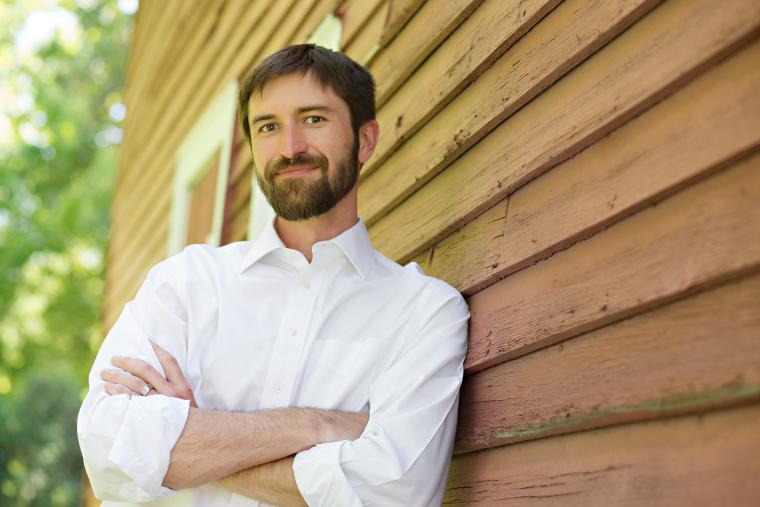Renewed Energy
August 7, 2014
Amanda Nagy

Sean Hayes is executive director of the Oberlin Project.
Photo credit: Tanya Rosen-Jones
As the new executive director of the Oberlin Project, Sean Hayes is shepherding an ambitious effort that aims to transform the local economy. The long-term goals of the Oberlin Project—reducing the city’s greenhouse gas emissions 50 percent by 2015; developing a local food hub that can meet 70 percent of the community’s consumption; and creating one of the first climate-positive cities in America, becoming climate positive by 2050, to name a few—could be perceived as lofty, but Hayes sees all of these goals as attainable.
At its core, the Oberlin Project is a collaboration between Oberlin College, the city of Oberlin, and local businesses. Hayes, a renewable energy specialist with a background in alternative fuels and building science, has approached his role with the philosophy that the best way to solve large, multifaceted problems is to develop partnerships rather than taking ownership of each issue in its entirety.
“As an organization, the Oberlin Project is designed to be transformative and catalytic,” he says. “The process I’m going through right now is getting a solid idea of where we have traction. I’m taking these complex problems and breaking them down into chewable bites.”
Hayes came to Oberlin in 2011 to become facilities manager and community outreach coordinator for the Adam Joseph Lewis Center for Environmental Studies. In that role, he optimized the building’s energy consumption and solar array production in his first year. He also managed the center’s Living Machine and the organic garden and orchard. Before coming to Oberlin, he did graduate work in waste-to-energy biofuels at Appalachian State University, where he received his master’s in appropriate technology.
His affection for Oberlin is apparent when outlining the Oberlin Project’s current goals: economic development, local foods, and energy. In a climate action plan driven by data points, he envisions every milestone leading to a more prosperous and revitalized community.
While much of the economic development discussion has revolved around the Green Arts District, the Oberlin Project recognizes a need for affordable, energy efficient housing stock in the city. “That has a multiplier effect,” Hayes says. “The reality is, it will reduce energy consumption, which reduces energy bills and our collective impact on the environment. Training and equipping local people to perform these jobs will work to eliminate underemployment and unemployment.”
A large piece of the Oberlin Project’s vision is encouraging the development of a local food hub. The ultimate goal is to establish a local food supply that can meet 70 percent of the population’s consumption—not an easy feat given the short growing season in northeast Ohio. However, Hayes notes that vendor participation in the Oberlin Farmer’s Market has increased steadily over the past three years.
“At its heart, it’s a place that aggregates food supply and demand in a central location. This would involve bulk buyers who can supply food for the college, Kendal at Oberlin, the public schools, and local restaurants. The New Agrarian Center is currently piloting a food buyer position, and that may be a logical first step in building a larger food hub. The collaboration with the New Agrarian Center is one of many ways we're working to develop relationships between consumers and farmers.”
Energy will always be a major issue for the Oberlin Project, particularly as the town and college work toward becoming a “climate positive city”—an initiative of the C40 Cities Climate Leadership Group and the Clinton Climate Initiative. Oberlin is one of 18 Climate Positive Development program cities globally and one of only three in the United States working to become a model for sustainability. Oberlin is the first partner site in North America to be accepted as a “climate positive participant.”
The City of Oberlin is on target to reduce its greenhouse gas emissions by 50 percent of 2007 levels by 2015, with the majority of its electricity coming from renewable sources. Oberlin’s climate action plan commits the city to reducing its greenhouse gas emissions 75 percent by 2030 and below zero by 2050.
“We’ve made significant progress on the energy front,” Hayes says. As of June, OMLPS, Oberlin’s community owned electric utility, has acquired 71 percent renewable energy sources in its portfolio. “We’re already light-years ahead of other communities. For the Oberlin Project, energy is a place where we already have great momentum.”
For the time being, there are still many questions to be answered. “The Oberlin Project is all-encompassing, yet still hard to define. It’s a collaboration that works with the college, the city, and local businesses. Doing it right is important.”
You may also like…
Josh Nolan Named Vice President, General Counsel, and Secretary at Oberlin
Distinguished attorney brings extensive experience in higher education law.
Learning by Teaching: Oberlin Students Share Global Music with Young Learners
College and Conservatory students in PACE 103 prepare local children for an immersive community concert at Oberlin.
Nuiko Wadden ’02 Joins Oberlin Conservatory Faculty as Assistant Professor of Harp
The versatile musician brings extensive opera, orchestral, and contemporary music experience to her role


